Recent Fire Damage Posts
How to Remove Soot and Smoke Residue from Surfaces
12/18/2023 (Permalink)
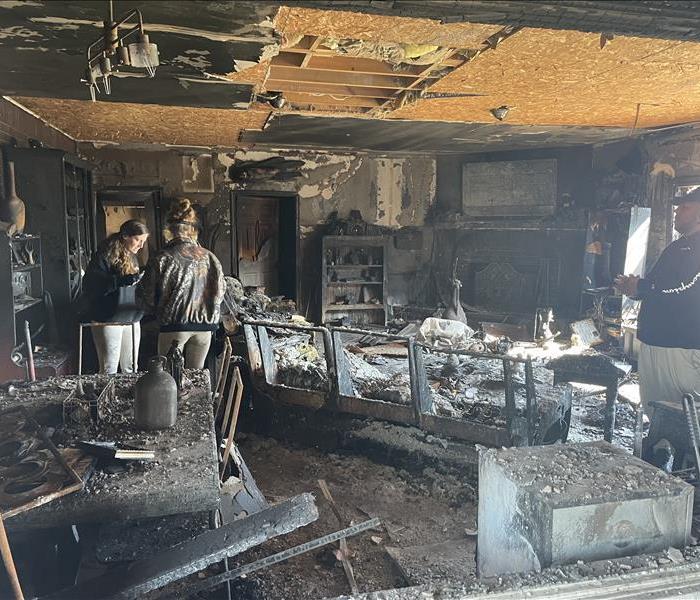 If you are unsure or dealing with extensive fire damage, it is recommended to consult with professional fire damage restoration experts.
If you are unsure or dealing with extensive fire damage, it is recommended to consult with professional fire damage restoration experts.
After a fire, one of the most challenging tasks of fire damage restoration is removing soot and smoke residue from surfaces. Soot and smoke particles can cling to various materials and surfaces, causing discoloration, odors, and secondary risks, if not properly addressed. In this blog, we will explore effective techniques for removing soot and smoke residue from surfaces, ensuring a thorough and successful fire damage restoration process.
Safety First
Before beginning any cleaning process, it is essential to prioritize safety. Wear protective gear such as gloves, goggles, and a respirator to protect yourself from potential health hazards. Open windows or use fans to provide adequate ventilation during the cleaning process.
Dry Cleaning
Dry cleaning methods are suitable for light or loose soot and can be used on surfaces that are delicate or prone to water damage. Start by vacuuming any loose soot particles with a vacuum cleaner equipped with a HEPA filter. Use a dry sponge or dry cleaning sponge to gently wipe away the remaining soot residue. Be careful not to apply excessive pressure, as it can push the soot deeper into the surface.
Wet Cleaning
Wet cleaning is appropriate for surfaces that can withstand moisture. Begin by testing a small, inconspicuous area to ensure that the cleaning solution does not cause discoloration or damage to the surface. Prepare a cleaning solution by mixing warm water with a mild detergent. Dip a sponge or cloth into the solution, wring out excess moisture, and gently wipe the soot-covered surface. Rinse the sponge or cloth frequently and change the cleaning solution as needed. Finally, use a clean, damp cloth to remove any remaining residue and allow the surface to dry thoroughly.
Professional Cleaning Products
There are various cleaning products available specifically designed for removing soot and smoke residue. Look for products that are suitable for the specific surface you are cleaning, such as upholstery, walls, or countertops. Follow the manufacturer's instructions carefully, and make sure to test the product in an inconspicuous area before applying it to larger surfaces.
Homemade Cleaning Solutions
If you prefer to use natural or homemade cleaning solutions, consider using vinegar or baking soda. Vinegar is acidic and can help break down soot and smoke residue. Mix equal parts of vinegar and water, apply the solution to the affected surface, and gently scrub with a soft cloth or sponge. Baking soda is an excellent deodorizer and can be used to neutralize odors. Create a paste by mixing baking soda with water, apply it to the soot-covered surface, and scrub gently.
Don't Forget Ventilation Systems
Soot and smoke residue can also accumulate in ventilation systems, contributing to lingering odors and potential recontamination. It is crucial to thoroughly clean and inspect air ducts, HVAC systems, and filters. Consider hiring professional duct cleaning services to ensure a comprehensive cleaning and restoration of these systems.
In conclusion, the removal of soot and smoke residue from surfaces requires careful consideration and effective techniques. Whether using dry or wet cleaning methods, professional cleaning products, or homemade solutions, it is essential to prioritize safety and test small areas before tackling larger surfaces. Remember to pay attention to ventilation systems to prevent recontamination and promote clean, fresh indoor air. If you are unsure or dealing with extensive fire damage, it is recommended to consult with professional fire damage restoration services who have the expertise and tools to effectively remove soot and smoke residue from surfaces, ensuring a thorough and successful restoration process.
How Emergency Board Up Services Can Save Your Property
9/12/2023 (Permalink)
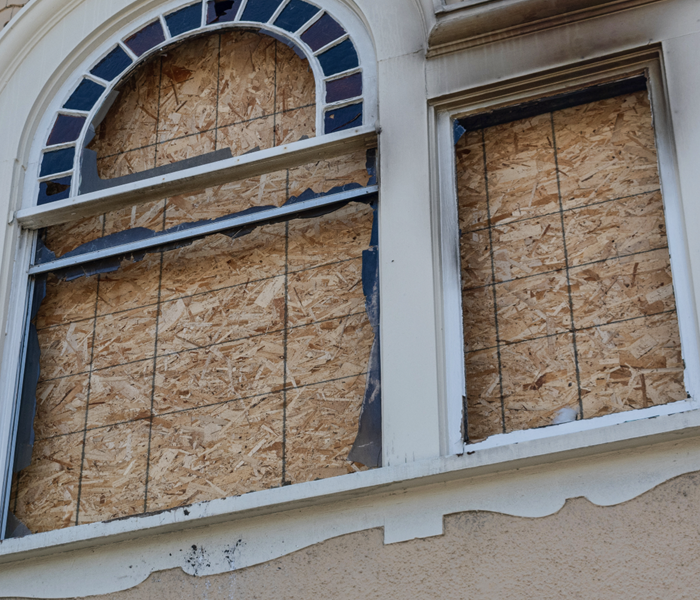 When disaster strikes, board up services help prevent your property from additional damages.
When disaster strikes, board up services help prevent your property from additional damages.
In times of disaster, such as severe storms, fires, or break-ins, your property may be exposed to various risks, including further damage, theft, or unauthorized entry. This is where emergency board up services come into play. These services offer a crucial solution to protect your property from additional harm and secure it until proper repairs can be made. In this blog post, we will explore the importance of emergency board up services and how they can save your property when disaster strikes. By understanding the benefits of this proactive measure, you can take swift action to safeguard your home or business in times of crisis.
Immediate Protection from Further Damage
When disaster strikes, your property may be left vulnerable to additional destruction. Broken windows, damaged doors, or compromised structural elements can expose your property to the elements, pests, and intruders. Emergency board up services provide an immediate solution by securing these openings, preventing further damage from weather, debris, or potential criminal activities.
Enhanced Security against Unauthorized Entry
An unsecured property is an invitation for theft, vandalism, or unauthorized entry. Emergency board up services effectively deter potential intruders by barricading access points and reinforcing weak areas. By installing sturdy boards or protective coverings, these services create a visible barrier, deterring opportunistic criminals and minimizing the risk of theft or vandalism.
Mitigation of Water and Weather Damage
Natural disasters often bring harsh weather conditions, such as heavy rains or high winds, which can lead to water damage and subsequent mold growth. Emergency board up services play a vital role in minimizing the exposure of your property to these elements. By sealing off broken windows, damaged roofs, or compromised entry points, these services can significantly reduce the risk of water intrusion, protecting your property from extensive water damage and associated issues.
Preservation of Personal Belongings
Your property is not just a structure; it holds your valuable possessions and cherished memories. Emergency board up services help preserve your belongings by creating a secure environment during a crisis. By safeguarding your property against potential looting or further damage, these services give you peace of mind that your personal items are protected until repairs can be made.
Insurance Compliance and Claims Assistance
In many cases, insurance policies require property owners to take immediate action to mitigate damage after a disaster. Failure to do so may result in denied or reduced insurance claims. Emergency board up services can assist you in complying with these requirements by providing documentation and proof of the steps taken to secure your property. This documentation can strengthen your insurance claims, ensuring a smoother and more efficient process.
When disaster strikes, every moment counts in protecting your property from further harm and securing your valuable assets. Emergency board up services offer a vital solution by promptly fortifying your property, preventing additional damage, and deterring unauthorized entry. By engaging these services, you can mitigate risks, preserve your belongings, and ensure compliance with insurance requirements. Remember, proactive measures are key to safeguarding your property in times of crisis. Take action, prioritize the security of your home or business, and partner with trusted emergency board up services to protect what matters most.
7 Essential Tips for Preventing Residential Fires
4/18/2023 (Permalink)
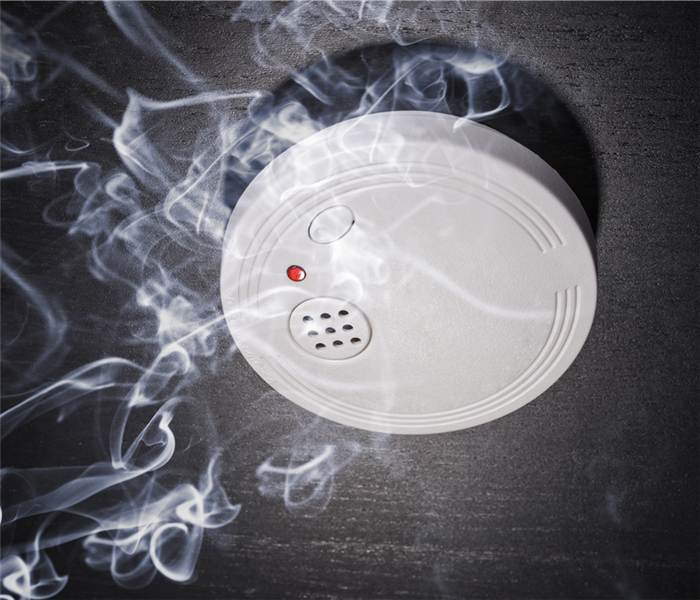 Smoke alarms are essential in detecting a fire early and giving you enough time to evacuate.
Smoke alarms are essential in detecting a fire early and giving you enough time to evacuate.
A residential fire can be devastating, causing damage to your property and putting your family's safety at risk. However, many residential fires are preventable with the right precautions and awareness. Here are some tips on how to prevent a residential fire:
1. Install smoke alarms and test them regularly.
Smoke alarms are essential in detecting a fire early and giving you enough time to evacuate. It is recommended that you install smoke alarms in every room of your house and test them at least once a month to ensure that they are working properly. If you have trouble hearing the alarm, consider installing one with a strobe light or a vibration feature.
2. Avoid overloading electrical outlets and circuits.
Overloading electrical outlets and circuits can cause a short circuit, leading to a fire. Make sure that you are not plugging too many appliances into one outlet or using extension cords in place of additional outlets. If you find that you need more outlets, consider hiring an electrician to install additional ones.
3. Keep flammable materials away from heat sources.
Flammable materials such as curtains, blankets, and papers should be kept away from heat sources such as stoves, heaters, and fireplaces. A good rule of thumb is to keep a distance of at least three feet between any flammable materials and a heat source.
4. Practice safe cooking habits.
Cooking is one of the leading causes of residential fires. To prevent fires while cooking, never leave the kitchen unattended while cooking on the stove. Also, keep flammable materials such as towels and paper products away from the stove. If a fire does break out while cooking, use a fire extinguisher or baking soda to put it out rather than water, which can spread the flames.
5. Don't leave candles unattended.
Candles can create a cozy atmosphere, but they can also be dangerous if left unattended. Always blow out candles before leaving the room or going to bed, and keep them away from flammable materials. Consider using flameless candles as a safer alternative.
6. Have a fire escape plan.
In case of a fire, it is important to have a plan in place for how to escape safely. Make sure that everyone in your household knows the plan and has practiced it. Identify two ways to escape from each room in the house and establish a designated meeting place outside.
7. Keep a fire extinguisher in your home.
A fire extinguisher can be a useful tool in putting out small fires before they become larger ones. Make sure that you have a fire extinguisher in your home and that you know how to use it. Check the expiration date on the extinguisher and replace it if necessary.
By following these tips, you can significantly reduce the risk of a residential fire. Remember that prevention is key, and taking the necessary precautions can keep your family and your home safe.
After the Fire – A Comprehensive Post-House Fire Checklist
12/29/2022 (Permalink)
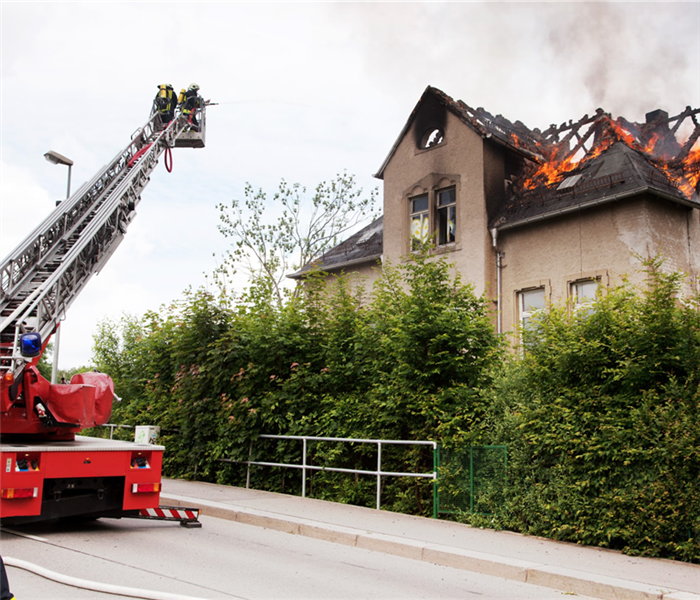 Fire damage in Baton Rouge, LA
Fire damage in Baton Rouge, LA
Suffering a house fire is one of the most devastating events a homeowner can experience. The loss of personal belongings and cherished keepsakes often leaves survivors feeling completely helpless. Thankfully, there are steps you can take to protect your property after experiencing a house fire. This comprehensive guide will walk you through everything from getting control over your insurance benefits and securing the perimeter of your home with board-up services to assessing damages and dealing with insurance claims adjusters.
Steps to Take Immediately Following a Fire
The moment your house catches on fire, you’ll be in a state of shock. You may not even know what to do first. Thankfully, there are a few steps you can take right away to ensure that everyone is safe and that the damage done by the fire is minimal.
First and foremost, call 911 as soon as possible. The sooner first responders are at your location, the sooner they can assess what’s happening and get control over it—or if necessary, help evacuate everyone from the building safely. Once they arrive on scene, they will direct you through each step needed for them to extinguish the flames and make sure that no one is left inside or exposed to hazardous chemicals/emissions such as carbon monoxide poisoning (see below).
Assess the Damage
The first thing you should do after a fire is assess the damage. This can be overwhelming, but it's important that you know exactly what you're looking for so that you can make an educated decision about where to go from there.
- Look for structural damage and stability. Structural damage refers to any changes in the physical structure of your home that occurred as a result of the fire. You'll want to inspect walls and floors, windows and doors, roofing materials, ceiling beams and supports (if possible), plumbing systems, electrical wiring/outlets/switches—everything!
- Check for smoke or water damage. Even if no flames were visible during the fire itself (or even if they weren't even suspected), there may still have been smoke damage hidden inside walls or ceilings. This means having an expert come in with specialized equipment like thermal imaging cameras, so they can determine whether there was enough heat generated that could potentially cause structural integrity issues down the road.
Back-Track to the Source
After the fire has been extinguished, you may be eager to see what happened and how much damage has been done. It’s important to back-track to the source of the fire so that you can prevent another one from happening.
- Investigate the cause of the fire: If it was an electrical issue, find out if there are any other problems in your home that could lead to another fire.
- Check for hazardous materials: If it wasn’t an electrical issue, check for any other possible causes like flammable liquids or gas leaks around your house. Also look at all of your belongings and make sure they aren’t leaking anything dangerous onto surfaces where they might ignite a new fire later on – this includes cleaning products!
Gather Valuable Documents and Information
One of the most important steps you can take after a house fire is to gather all of your valuable documents and information. This includes copies of birth certificates, marriage licenses and divorce decrees, Social Security cards (and numbers), passports and immigration papers, wills, deeds to real estate—anything that may be necessary for insurance companies or creditors to prove ownership of property.
Once you’ve begun rebuilding your life after the fire, it’s important that these documents are stored safely in case they are needed later on. Some people choose to use an online cloud service like Dropbox or Google Drive; others prefer using a hard drive or flash drive. The choice is up to you!
Evaluate Your Insurance Benefits and Plan Ahead
After the fire, it’s important to collect your insurance information and determine the amount of coverage you have. In addition to making a list of what is covered and what isn't, you should also ask about any exclusions or limitations on your policy. Your insurance company may be able to help you get an estimate for repair costs.
Make a List of Damaged Items
Once the fire is out, you will have time to make a list of damaged items and the rooms they were located in. You should also note how much damage was done to each item. This will be helpful when it comes time to file an insurance claim and replace your belongings.
If firefighters were able to recover any of your possessions, it's important to check with your insurance company to see if they can help you with a claim. Your policy may cover items that were damaged but not destroyed in the fire. If so, you may be able to recover those belongings from the insurance company and donate them to a charity organization that can use them for good.
Securing Your Home with Board-Up Services
After you and your family have safely returned to your home following a devastating house fire, it is important to take steps to secure the perimeter of your home and protect yourself from intruders. If you are not able to secure the perimeter of your home, either by yourself or with help from a board-up company, you may find that strangers enter your property and steal items. This can be especially dangerous for homeowners who have lost their homes in fires because they will likely have minimal possessions left after such an event.
If you’ve been the victim of a house fire, the last thing you want to do is feel like you are alone in this difficult time. A professional fire restoration company, like SERVPRO of South Baton Rouge will be there for you every step of the way. We understand what it means to go through something like this and we want to help ease some of your stress. If at any time during the process, you have questions about getting back on your feet again or just need someone else who understands what it’s like – don’t hesitate to reach out! We will get your Baton Rouge, LA home back to normal as quickly as possible.
Tips for Creating a Home Fire Escape Plan
8/29/2022 (Permalink)
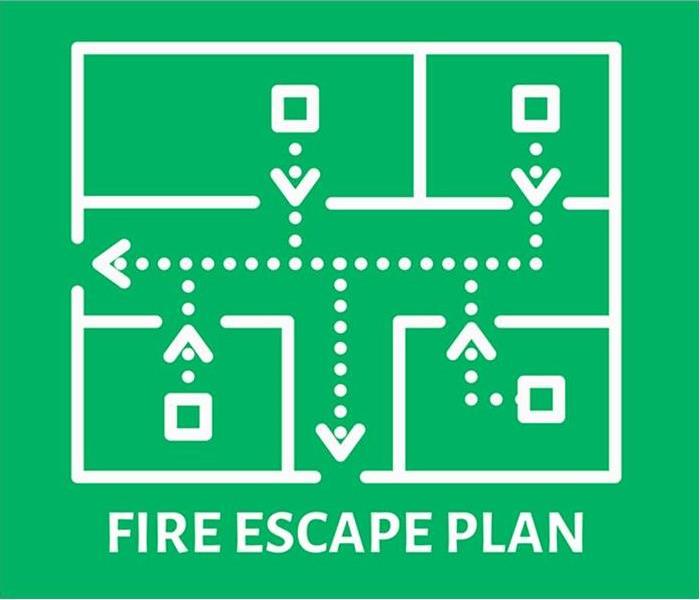 Create a fire escape plan for your home
Create a fire escape plan for your home
During a home fire, you may only have minutes to escape your Gardere, LA, property. You and your loved ones will not have time to figure out a fire escape plan. That is why you need to come up with a fire preparation strategy ahead of time.
Making Your Plan
Involve every member of your household in the planning process. Each person should know the locations of the smoke alarms and the windows and doors.
Next, pick a meeting place outside of your home. This way, everyone will know where to go after leaving the house. Common meeting places include:
- Stop signs
- Light posts
- Mailboxes
- Neighbors' homes
Any security bars on your windows and doors may make it hard for family members to exit the home quickly. As you create your fire escape plan, make sure the bars have emergency release devices.
Finally, have every person in your house memorize the phone numbers for your local fire department and emergency restoration company. That way, someone will be able to contact these professionals from safely outside the home.
Practicing Your Plan
You should practice your escape plan twice each year. This will let you see if there are any faults in your strategy and give you time to correct them.
As each person exits the house during the drill, he or she should practice closing the doors behind them. This can slow the spread of a real fire. If you have an escape ladder, every member of the home should practice locating and using it.
You should also practice a scenario where you or a loved one are trapped in the home due to smoke or fire. In this scenario, you should seal yourself into a room by closing the door and covering and vents or door cracks.
A blaze in your home can be a scary situation. However, having a fire escape plan in place should help everyone keep calm during an emergency.
3 Details of Fire Escape Your Kids Need To Know
5/30/2022 (Permalink)
 It is important to include children in the preparation of a house fire.
It is important to include children in the preparation of a house fire.
Three Things Your Kids Should Know About Fire Escape
Talking with your kids about fire safety might seem a little nerve-racking, but having the right information is crucial to ensuring kids' safety. Clear communication about your fire escape plan helps the whole family to be prepared. Even if you've already covered the basics of escaping a home fire in Baton Rouge, LA, with your children, there are a few details that you may want to revisit and practice during your next fire safety review.
1. Stay Low
There are two important scenarios during which your kids will need to remember to stay low when escaping a house fire:
- Getting out of bed: Have your kids practice safely rolling out of their beds onto the floor. Because heat rises, they should avoid sitting up to get out of bed during a fire.
- Moving through the house: Practice crawling on hands and knees through your home to your fire exits. Also practice crawling with the belly to the ground, in the case of extreme heat.
2. Don't Hide
It is important to remind children to never hide during a fire. The impulse to hide in the midst of a crisis is understandable, but it compromises kids' safety by making it harder for firefighters to find them. If they are unable to safely exit the home, they should stay put where they can be found quickly, such as lying on the floor next to their bed.
3. Pick a Meeting Spot
Talk ahead of time about where you will meet after exiting your home. Choose a spot that is easy to get to but a safe distance from the house. Have your children practice meeting there so they will remember if the time comes.
Practicing these steps helps to secure your kids' safety. In the event of a fire, everybody reaching safety and gathering at your meeting place enables you to focus on the next steps. These include finding a safe place to stay while you have a fire damage assessment done on your home. Clear communication with your children is key to both preparing for the event of a home fire and navigating any changes afterward.
How To Get Rid of Stubborn Smoke Smells
4/18/2022 (Permalink)
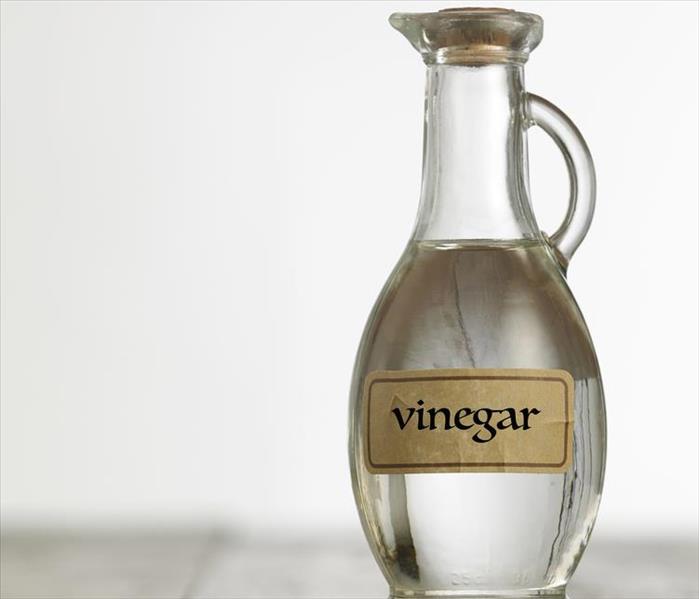 The strong smell of smoke damage can be neutralized with vinegar.
The strong smell of smoke damage can be neutralized with vinegar.
Removing Smoke Odor In Your Home
Whether from a fire or from a bad cigarette habit, smoke cleaning can be difficult and frustrating. No matter how hard you scrub, the smell seems to linger in your Arlington, LA, home and you feel as if your space will never be the same. Here are some steps that may help you get a good start on it before you reach out to a professional odor elimination specialist.
Determine the Source
There are a variety of reasons you may have a stubborn smoke odor in your home. Determining the source will help you decide the best route to get it cleared out. The smell may come from fire damage, years of indoor cigarette smoking, or even from outdoor wildfires near your home. The smell will leach into fabrics and any porous surface in your home, including furniture, clothing, dishes, floors and walls.
Neutralize With Vinegar
The strong smell of smoke damage can be neutralized with vinegar. Begin by placing several small bowls around the area where the odor is strongest. These will begin to absorb the noxious fumes and reduce the smell. You can also boil some vinegar on the stove to speed up the process, allowing it to simmer for an hour or two.
Clean, Clean, Clean
Smoke cleaning will also require you to remove and thoroughly scrub anything that was within the damaged area. All clothing, furniture cushions, or other fabric items should be washed. You'll also need to clean wall hangings and hard surfaces. Sprinkle baking soda on carpets and allow it to sit for a while before vacuuming up.
Use Ammonia
The most stubborn smells may require an ammonia treatment to fully destroy them. You can add some to the laundry when washing clothing, bedding and other fabrics. The stronger smell will be more unpleasant than vinegar, but you can also place bowls of ammonia throughout the home to absorb smoke smells.
Smoke cleaning takes a lot of work, but the time invested is worth it if you can eliminate the smell. Follow these tips to do it right.
Steps to Take After Your Business Suffers Fire Damage
3/23/2022 (Permalink)
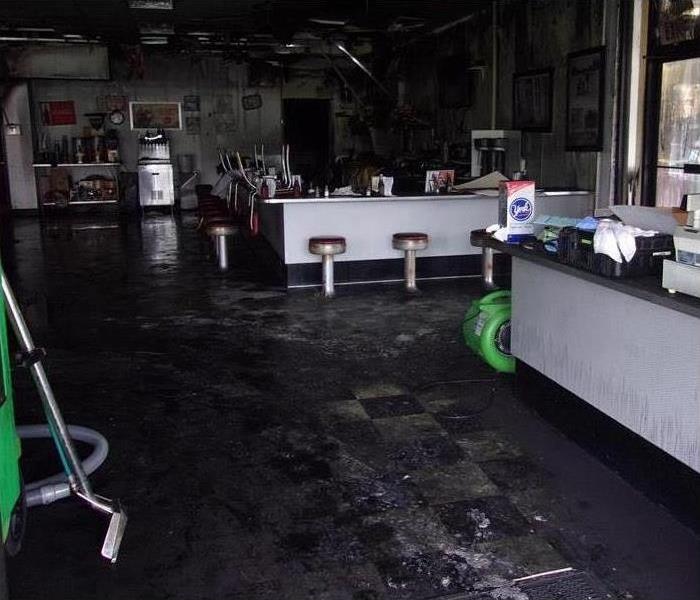 The aftermath of a fire in Baton Rouge, LA.
The aftermath of a fire in Baton Rouge, LA.
Fire Restoration Process
A fire is a devastating incident, and you may feel overwhelmed if your business in Baton Rouge, LA, has been affected by fire damage. There are some key steps you should take in the aftermath of a fire in order to ensure that your business is up and running again as seamlessly as possible. Here are some tips to guide you through the fire restoration process and ensure that everything returns to normal again.
Stay Away From Damage
While you may be tempted to try to repair objects that have been damaged by the fire, it is best not to touch any damaged items in your business. Take the following precautions when surveying the effects of the fire:
- Avoid washing walls or painted surfaces
- Do not turn on lighting fixtures if walls or ceiling are wet
- Keep your hands clean to avoid spreading soot particles
- Refrain from cleaning damaged electronics
Staying away from damaged articles until a professional arrives can help prevent your business from undergoing further damage.
Call Your Insurance Company
Make sure to call your insurance company as soon as possible to report the fire damage. The faster you inform them of your loss, the faster you can focus on fire restoration and the less likely you are to miss important deadlines. Once you’ve spoken with an agent, you can make a fire insurance claim. Taking care of the logistics after an incident can help you be well informed during a stressful situation.
Turn off Utilities
Until help arrives, it is crucial to do what you can to minimize further damage. Turn off all the utilities in your building, including gas, electricity and water. You can shut off the water at the main valve and turn off gas and electricity at the meter. Once you’ve done this, refrain from using any utilities until a professional has inspected them properly.
Whether you need smoke cleaning services or water removal from firefighting efforts, a skilled fire restoration professional can conduct a fire damage assessment and help bring your business back to normal.
Keep Your Pet Safe in a Home Fire With a Pet Evacuation Plan
2/23/2022 (Permalink)
 Keep your pets and family members safe by having a well thought out plan if a fire emergency ever does occur.
Keep your pets and family members safe by having a well thought out plan if a fire emergency ever does occur.
With A Pet Evacuation Plan, You Can Keep Your Pet Safe In The Event Of A House Fire.
If a fire occurs in your home in Erie, CO, your first priority should always be to get yourself and all your family members out safely. While you should leave belongings behind until a fire restoration company can retrieve them, you will likely not want to leave your pets behind. It is important you have a plan in place to evacuate your pets in case a fire emergency ever occurs. A good place to start is by including your pets into your home escape plan.
5 Pet Preparation Tasks You Should Complete
Preparation is key when it comes to protecting your pets in a fire. In case your pets are in an unsafe location that you or your other family members can’t get to, there are several steps you can take to better the chance of their rescue:
- Place your pet near a door so firefighters can quickly save them.
- Keep an updated pet alert window sling on the front window of your home.
- Set aside a disaster supply kit just for your pet in the case of a fire emergency.
- Place important pet ownership documents and proof of vaccinations in a fire box.
- Teach your pets the “Come” command so you can easily direct them towards you.
Creating Your Pet Evacuation Plan
In addition to these important pet safety tasks, you will need to create a pet evacuation plan for your pets. Assign a specific individual or two to being in charge of retrieving the pets. If your pets are located in a specific part of the house during the night, identify several different routes to that location. Lastly, make sure to practice the evacuation plan several times.
Keep your pets and family members safe by having a well thought out plan if a fire emergency ever does occur. While your pets might be able to escape safely on their own, you can increase the chance of their rescue with these tips!
 If you are unsure or dealing with extensive fire damage, it is recommended to consult with professional fire damage restoration experts.
If you are unsure or dealing with extensive fire damage, it is recommended to consult with professional fire damage restoration experts.



 24/7 Emergency Service
24/7 Emergency Service







